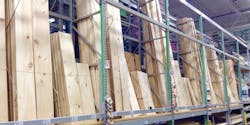A Look at Lumber Prices From the Supply Side
Those of us in the lumber and building materials (LBM) industry can recall moments when we’ve uttered, “I’ve never seen anything like this,” when referring to a particular market dynamic. I can say with confidence that the market conditions of 2020 and early 2021 are examples of a supply chain and pricing environment most of us have truly never encountered.
Lumber Prices—How We Got Here
By now, the story is cemented of how we arrived in the situation we face today. In January and February of 2020, the price of lumber and panels began to fall due to an expectation within the LBM industry of waning demand and that inventories were sufficient.
A month later, in March 2020, COVID-19 threw a wrench into everything, causing uncertainty across all industries. Notably and reasonably, LBM manufacturers across North America took cues from the declining prices and slowing demand of the previous two months and determined that those factors would continue for the foreseeable future as the pandemic shut down or slowed construction activity.
What they didn’t factor, and could not have foreseen, was that homeowners now forced to work from home began an incredible surge in repair and remodeling projects to create at-home workspaces or extend and improve outdoor living spaces—a dynamic that set the stage for an unexpected boom in demand for a variety of LBM products.
RELATED
- Lumber Prices Hit Record High, Threatening Housing's Momentum
- Home Builders, How’s Your Supply Chain?
- Lumber Prices: How Builders Are Managing
Furthermore, homebuyers and renters started to flee the tight confines of urban living and began looking for opportunities to move to the often more affordable (and more spacious) suburbs and away from cities. Interest rates also hit record lows, making homebuying more accessible. New-home builders, while somewhat restricted on jobsites with COVID safety protocols, for the most part were allowed to continue building … and were more than happy to welcome a wave of home shoppers.
The combination of these factors sent the demand quotient for LBM skyrocketing. And this unexpected demand happened in conjunction with suppliers across North America taking production to lower levels by choice, by COVID-related disruptions, or both. By the summer of 2020, the industry realized that the just-in-time style of procuring through the supply chain that dominated the LBM purchasing environment since the Great Recession had become completely insufficient to meet this surging demand.
What’s Happening Now for LBM Dealers
To adapt to the current supply chain restraints, the Lumbermens Merchandising Corporation (LMC) recommends that our LBM dealers review their purchasing strategies and increase their levels of communication within the chain.
Everyone who buys LBM products—builders, contractors, lumberyards, and distributors alike—has a purchasing strategy. For most of them, the prevailing practice includes some version of just-in-time buying, an effort to keep as little inventory on the ground as possible, refer to upcoming order files, and order for arrival in what was a traditional two-to-three-week lead time.
What’s happening now has shifted the risk from maintaining the lowest inventory position possible—and its goal of maintaining the lowest possible prices—to an environment where we are running out of inventory, resulting in a straightforward supply-and-demand economic situation that results in higher prices.
Why Communication With Your Suppliers Is Key
If you are a builder, you need to work more closely with your suppliers, discuss your order files more frequently, and work to develop your capacity to forecast further out than in the past.
The same is true for a lumberyard; lean on established supply chain channels and work with those partners to tell them of upcoming needs well in advance of the actual purchase.
“The market dynamics of the last two years have driven the need for much more frequent and closer communication and collaboration with customers in terms of planning, forecasting, market information, and most importantly, risk management processes,” says Steve Hansen, EVP of purchasing for Professional Builders Supply (PBS), in Morrisville, N.C. “It is fundamental to the preservation and protection of product availability and margins throughout the entire supply chain from mills to builders.”
The velocity with which pricing and production changes are being realized today, coupled with somewhat diminishing ability to utilize historical trends in predicting seasonal or cyclical market direction, he says, are further driving the need for closer partnering with suppliers and customers in the sharing of market information.
Pricing and supply pressures today are driving the need for closer partnering by LBM suppliers and their customers in sharing market information.
As part of PBS’ support of customers in this regard, Hansen reports that routine market commentaries are produced to assist its customers in their planning and timing of purchases to maximize their efficiencies and production. These commentaries are followed up with direct dialogue and application of risk management tools and processes to optimize the builders’ abilities to meet end-customer objectives.
In addition, LMC’s Lumber, Millwork, and Futures Trading groups, in particular, all play key roles in providing weekly and, at times, daily support of the most contemporary marketplace information and strategies that PBS employs in these efforts, Hansen says.
The LBM business is a bright spot in an otherwise dark time. Those of us in this industry are fortunate to be so busy. With this benefit comes additional work—and changes in how we operate compared with the conditions that endured in the markets for the past decade will only add more.
To get through this time, evaluate your current purchasing strategy and adapt to the changes in the risk variant that prevails today. Create an environment of over-communication, engage your existing partners in a meaningful way, and be prepared to convey your forecasted needs in a manner that differs from past practices.


